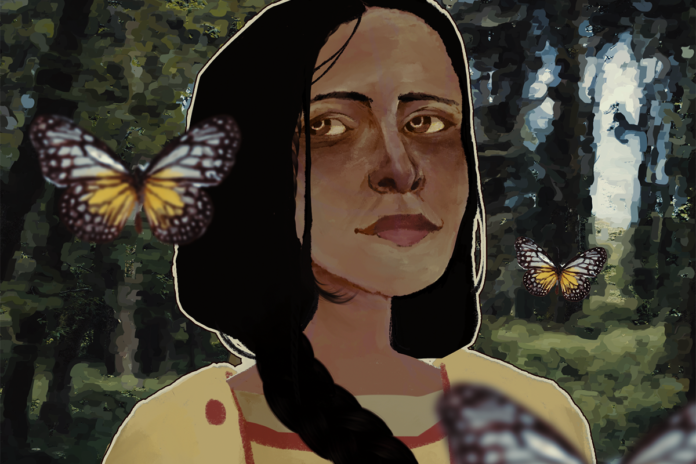
The University of Winnipeg recently hosted a virtual launch for an illustrated storybook celebrating the language, stories and children of the Asiniskow Īthiniwak (Rocky Cree).
Written by Rocky Cree storyteller William Dumas and illustrated by Rhian Brynjolson, Amō’s Sapotawan follows a Rocky Cree girl in the 17th century searching for her mīthikowisiwin, the gift she will seek to master.
Amō’s Sapotawan is the second instalment of The Six Seasons of the Asiniskaw Īthiniwak: Reclamation, Regeneration, Reconciliation, a series of picture books created to preserve language and drive cultural reclamation for Rocky Cree peoples. This Six Seasons project ultimately supports efforts to preserve and revitalize Indigenous language, history and knowledge in accordance with the Truth and Reconciliation Commission Calls to Action.
Dumas is a key creative force behind the project, having also written Pīsim Finds Her Miskanaw, the first book in the series and a tale of 13-year-old Pīsim seeking her miskanaw (life purpose) in the mid-17th century. Collaborating with team members was key to creating the project, Dumas said at the Oct. 11 launch.
“Somebody says that I’m the leader,” he said. “I’m not the leader. We walk side by side. That’s when the great magic happens—when people collaborate.”
According to Dumas, who recently became a great-grandfather, the future generation motivates much of his work.
“I’m so grateful we’ve come a long way,” he said. “That’s what motivated me to pass on stories, generation after generation. They will live now.”
Amō, the protagonist in Amō’s Sapotawan, follows the Rocky Cree ceremony called sapotawan, in which children choose which of their birth gifts they will refine. Dumas explained the ceremony’s name: “There’s this rock in your way, but you have to learn to go through with it—sapotawan.”
Dumas’s wife Margaret, a Cree educator and member of the project’s curriculum team, spoke at the book launch about the importance of ceremony and sapotawan in education.
“We talk about children needing to know who they are,” she said. “So, the sapotowan is the beginning of their education—being born and then being acknowledged for being born.”
Margaret Dumas added all children “deserve to be recognized” and must themselves start to recognize what their path will be.
“The sapotowan is the beginning of their education—being born and then being acknowledged for being born.”
The Six Seasons project is funded by the federal Social Sciences and Humanities Research Council in partnership with the University of Winnipeg and Indigenous communities, non-profits and educators. Project director Mavis Reimer said as many as 60 people contribute on any given day through research and on-the-ground work.
“We often have student research assistants, in addition to the academic researchers and the community researchers,” Reimer said. “We have a lot of land-based people who work with us in our two partnering communities, O-Pipon-Na-Piwin Cree Nation of South Indian Lake and the Nisichawayasihk Cree Nation.”
The group behind the Six Seasons project is already working on the next instalment in the series that’s set in the fall, according to story team member Warren Carriou.
“It’s a story about healing,” he said. “It’s a story about medicines and life on the land. And it’s just so important in terms of the Cree teachings that we’ve been learning from the knowledge keepers.”
Like the first book in the series, later turned into an interactive book app with a teacher’s guide, Amō’s Sapotawan is designed for education in a variety of classroom settings.
“We see one of the destinations for these books as being public school classrooms, both in First Nations communities and in other Canadian public school classrooms,” Reimer said. “The curriculum team becomes very important with educators like Margaret, who have experience in the classroom.”
For Margaret Dumas, the books also offer Indigenous youth the opportunity to see themselves in what they read.
“For Indigenous youth, especially Indigenous girls, they rarely get to see in books themselves as heroines or heroes,” she said, adding she sees both Pīsim and Amō as heroines. “I think that’s what’s missing, because they need an opportunity to see that youth their age were actually heroines.”
Featured graphic by Yanjano Banda.





